Steven Sidor's Blog
October 24, 2011
Texarkana Moonlight Murders
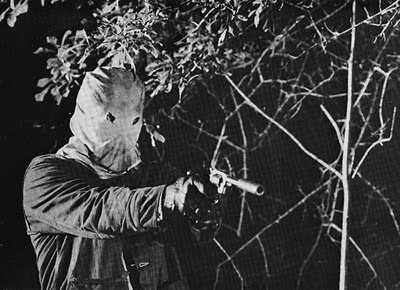 Texarkana, 1946: the Phantom Killer strikes. He hunts the lovers' lanes. He may visit your farm late at night. Before his reign of terror ends, this hooded ghost will kill five victims. The good people of Texarkana will live in fear. Law enforcement will come up empty-handed time after time. And, in 1976, the pseudo-documentary The Town That Dreaded Sundown tells their story. First off, great title. I rented this movie years ago on VHS. The sound quality was horrible. But the scratchy yellow print only added to the grittiness of the story. There are lots of reasons to seek it out. Ben Johnson as a Texas Ranger, for one. See Gilligan's Island's Mary Ann (Dawn Wells) get attacked. The killer is scary and raw. It's more Dragnet than Halloween. The vibe of the pic is lurid, tabloid, and rural at its core. A few comic sequences don't work at all. But the trashy, drive-in, fun-o-meter dives into the red most of the time. Chilling. That mask! That breathing! That trombone! By the way, the Phantom Killer was never caught.
Texarkana, 1946: the Phantom Killer strikes. He hunts the lovers' lanes. He may visit your farm late at night. Before his reign of terror ends, this hooded ghost will kill five victims. The good people of Texarkana will live in fear. Law enforcement will come up empty-handed time after time. And, in 1976, the pseudo-documentary The Town That Dreaded Sundown tells their story. First off, great title. I rented this movie years ago on VHS. The sound quality was horrible. But the scratchy yellow print only added to the grittiness of the story. There are lots of reasons to seek it out. Ben Johnson as a Texas Ranger, for one. See Gilligan's Island's Mary Ann (Dawn Wells) get attacked. The killer is scary and raw. It's more Dragnet than Halloween. The vibe of the pic is lurid, tabloid, and rural at its core. A few comic sequences don't work at all. But the trashy, drive-in, fun-o-meter dives into the red most of the time. Chilling. That mask! That breathing! That trombone! By the way, the Phantom Killer was never caught.
Published on October 24, 2011 19:11
October 3, 2011
The Andromeda Strain
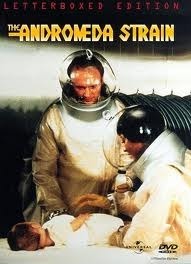 Early Michael Crichton is the best, and none come better than 1969's The Andromeda Strain. Taut, chilling, and totally believable -- Crichton's breakout science fiction/techno/medical thriller holds up over forty years after it was written. Crichton presents the story as a false document, which is one reason it doesn't feel dated despite revolutions in biology and medicine. It reads like a bio-nightmare from another time, yet it's horrors as just as scary and relevant today. Robert Wise's excellent film adaptation holds up equally well (forget about the TV remake, trust me). I once watched the Wise film in a bar in Grinnell, IA with a couple of townies after I had finished my final exams early. A great way to unwind. I haven't seen Soderbergh's Contagion yet. But, as far as bio-terror fiction goes, it will be hard to top the Crichton/Wise efforts for style, tension, and pure entertainment.
Early Michael Crichton is the best, and none come better than 1969's The Andromeda Strain. Taut, chilling, and totally believable -- Crichton's breakout science fiction/techno/medical thriller holds up over forty years after it was written. Crichton presents the story as a false document, which is one reason it doesn't feel dated despite revolutions in biology and medicine. It reads like a bio-nightmare from another time, yet it's horrors as just as scary and relevant today. Robert Wise's excellent film adaptation holds up equally well (forget about the TV remake, trust me). I once watched the Wise film in a bar in Grinnell, IA with a couple of townies after I had finished my final exams early. A great way to unwind. I haven't seen Soderbergh's Contagion yet. But, as far as bio-terror fiction goes, it will be hard to top the Crichton/Wise efforts for style, tension, and pure entertainment.
Published on October 03, 2011 11:01
July 17, 2011
All Aboard! the Horror Express
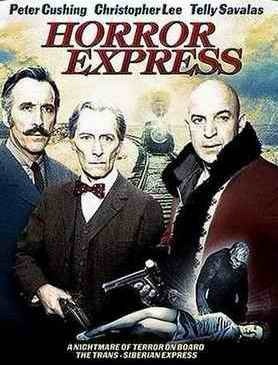 Horror Express (1972) is one crazy-ass movie that scared the pee out of me when I was a kid. I remember staying up late, eating Polish sausage, onion, and Open Pit sandwiches, while sucking Schweppes ginger ale from a can and watching this bad boy between burps. Now I can't really explain the plot, but it's unlike anything you've seen before. It's horror/sci-fi on a train with a Spaghetti Western vibe. Packed inside you'll find missing links, mad monks, aliens, Satan, spies, trepanning, evil eyes, the trans-Siberian railroad, pseudoscience, secret formulas, zombies, and did I mention Telly Savalas as a hotheaded Cossack? Christopher Lee and Peter Cushing anchor the picture as a pair of British scientists defending the train from Eee-vil. The music is great, creepy, and wonderfully overdone. It all goes down like a Polish sausage, onion, and Open Pit sandwich. Make mine a double. And don't forget the Schweppes!
Horror Express (1972) is one crazy-ass movie that scared the pee out of me when I was a kid. I remember staying up late, eating Polish sausage, onion, and Open Pit sandwiches, while sucking Schweppes ginger ale from a can and watching this bad boy between burps. Now I can't really explain the plot, but it's unlike anything you've seen before. It's horror/sci-fi on a train with a Spaghetti Western vibe. Packed inside you'll find missing links, mad monks, aliens, Satan, spies, trepanning, evil eyes, the trans-Siberian railroad, pseudoscience, secret formulas, zombies, and did I mention Telly Savalas as a hotheaded Cossack? Christopher Lee and Peter Cushing anchor the picture as a pair of British scientists defending the train from Eee-vil. The music is great, creepy, and wonderfully overdone. It all goes down like a Polish sausage, onion, and Open Pit sandwich. Make mine a double. And don't forget the Schweppes!
Published on July 17, 2011 12:18
May 5, 2011
Used & Abused: Our Lady Of Darkness
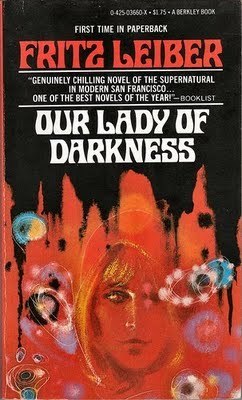 Fritz Leiber wrote two of my favorite horror stories ("Smoke Ghost" and "The Terror from the Depths") and one of my favorite Lovecraftian novels (Our Lady of Darkness). I first read him when I was in grade school, and I bought a used paperback of Swords and Ice Magic, a late entry in his famous Fafhrd and the Gray Mouser swords-and-sorcery series. Leiber was a disciple of Lovecraft, and he's at his best when working the Lovecraftian terrain. He mines the connection between modern architecture and the occult like no other, whether he's talking about Simon Rodia's bizarre and beautiful Watts Towers in "The Terror from the Depths" or the haunting cityscape of San Francisco in Our Lady of Darkness.
Fritz Leiber wrote two of my favorite horror stories ("Smoke Ghost" and "The Terror from the Depths") and one of my favorite Lovecraftian novels (Our Lady of Darkness). I first read him when I was in grade school, and I bought a used paperback of Swords and Ice Magic, a late entry in his famous Fafhrd and the Gray Mouser swords-and-sorcery series. Leiber was a disciple of Lovecraft, and he's at his best when working the Lovecraftian terrain. He mines the connection between modern architecture and the occult like no other, whether he's talking about Simon Rodia's bizarre and beautiful Watts Towers in "The Terror from the Depths" or the haunting cityscape of San Francisco in Our Lady of Darkness.Leiber is a writer's writer, with a supple and subtle prose style, an eye for spooky detail, and a pervasive sense of humanity amid the strangeness. The semi-autobiographical hero of Our Lady of Darkness is a horror writer, an alcoholic widower coming off a three-year bender, who starts seeing an otherworldly entity ("the Noseless One") through his binoculars while looking out his window one day. Leiber studs the novel with arcane ciphered texts, pseudoscientific concepts like "paramentals" and "megapolisomancy," and real-life literary adventurers including Clark Ashton Smith, Jack London, Ambrose Bierce, and George Sterling. Leiber is able to take the mundane and imbue it with weirdness, making us reevaluate what we accept daily as "reality." I have never looked at San Francisco the same after reading this book. You won't either.
Published on May 05, 2011 06:30
April 26, 2011
PITCH DARK NOW ON SALE!
 What if you stole something from the most dangerous cult in the world? Where would you go? How could you hide? And what would happen if they found you? My new supernatural thriller, PITCH DARK, is now on sale! Buy it from your favorite bookstore, or download it on Kindle. Get ready to be afraid of the dark.
What if you stole something from the most dangerous cult in the world? Where would you go? How could you hide? And what would happen if they found you? My new supernatural thriller, PITCH DARK, is now on sale! Buy it from your favorite bookstore, or download it on Kindle. Get ready to be afraid of the dark.
Published on April 26, 2011 06:23
April 5, 2011
The Amityville Horror: Why It Works
 Is Shirley Jackson's The Haunting of Hill House the most famous tale of a haunted house in fiction? Perhaps. Richard Matheson's Hell House, clearly inspired by Jackson, is more visceral and, in my opinion, scarier. I would also recommend Edward Lee's Flesh Gothic, an excellent updating of the Jackson psychic-haunting-investigation template. But the haunted house that scared me the most as a kid is the Dutch Colonial located at 112 Ocean Ave. in Amityville, NY. I nominate it as the most famous haunted house in fiction. But wasn't The Amityville Horror non-fiction? Sorta. Was it debunked as a hoax? Kinda. But I honestly don't care about the truth of it. I care about the story. And the story is good. It has legs. It has endured and grown, as all good legends do.
Is Shirley Jackson's The Haunting of Hill House the most famous tale of a haunted house in fiction? Perhaps. Richard Matheson's Hell House, clearly inspired by Jackson, is more visceral and, in my opinion, scarier. I would also recommend Edward Lee's Flesh Gothic, an excellent updating of the Jackson psychic-haunting-investigation template. But the haunted house that scared me the most as a kid is the Dutch Colonial located at 112 Ocean Ave. in Amityville, NY. I nominate it as the most famous haunted house in fiction. But wasn't The Amityville Horror non-fiction? Sorta. Was it debunked as a hoax? Kinda. But I honestly don't care about the truth of it. I care about the story. And the story is good. It has legs. It has endured and grown, as all good legends do.Let's start with the ghastly origins. In the early hours of November 13th, 1974, a heroin abusing 23 year-old, Ronnie DeFeo, murdered six members of his family. He shot them with a Marlin rifle while they lay on their stomachs in bed. He killed his parents and four younger siblings. Later, he went to a local bar and talked about the killings. He was arrested, convicted, and he rots in prison to this day. Some have disputed that Ronnie acted alone. How exactly do you shoot six people with a rifle and no neighbors hear the shots? Why were the victims still in their beds after the attack began and ALL sleeping on their stomachs? I don't know. But let's say Ronnie did it. The cops got the right guy. Justice was served. Okay, good.
In December 1975, newlyweds George and Kathy Lutz moved their family (Kathy had three kids from a previous marriage) into the former DeFeo home, which they purchased at a bargain price because of its notoriety. They even bought some of the old furniture, including two bedroom sets. Creepy or cheap, I can't decide.
Now stop.
Everything after this point makes my bullshit detector go haywire. But it doesn't matter unless you want to believe that what the Lutz family reported is true.
Isn't that how every good campfire ghost story begins?
"This really happened . . ."
Well, I don't think it did. Or not the way we've been told. See, a lot of different people contributed to the Amityville legend, and they all had motives, and telling the truth wasn't high on their list. First off, the Lutzes met with DeFeo's defense attorney who was mounting an insanity defense. Over bottles of wine, they discussed weird occurrences in the house. They brainstormed. The lawyer got the idea of writing a book. Then he was surprised to discover later that the Lutzes had connected with a writer on their own in an attempt to sell their story. Cut out of the deal, he's been debunking their "hoax" even since. Jay Anson, who wrote the bestselling book, NEVER met the Lutzes, and the Lutzes admitted he exaggerated, changed events around, and even made up stuff. Anson defended himself by saying he was a writer and he wanted to make money. He lifted his title from Lovecraft's The Dunwich Horror. Anson's book is reportorial, spare, and frightening -- I can see why it made big bucks. A media circus followed. Less-than-credible demonologists Ed and Lorraine Warren got involved. Ghost investigator Hans Holzer brought in a trance medium who channeled a Shinnecock Indian chief angered because the house was built on burial grounds. Great stuff. But true? Mmm . . . I don't think so. The movie poster gave us the spooky, iconic, round quarter windows glaring out like jack o' lantern eyes. Cinematics turned up the volume and explosive evil forces, capturing the momentum of a previous demonic big hit, The Exorcist. Now we've had sequels and remakes and books about the book . . . see why it's hard to swallow? But the story works. Why? Details. How many do I remember after years?
-the secret "red room" in the basement
-Jodie the Pig with the red eyes who left footprints in the snow
-Father Mancuso/Pecoraro getting slapped and told, "Get out!"
-the Lutzes moving out after 28 days
-flies on the wall
-blisters on the priest's hands
-blackened toilet bowls
-oozing slime on the walls
-waking up every night at the time of the DeFeo murders
-George chopping wood because he can't get warm
-Kathy levitating in bed
-the crucifix on the wall turning upside-down
Whew! I've got a good memory, but I'm sure you recall some of those same details. That's how we remember stories -- we string together strong details. I think this particular cloud of details is so potent it has lasted, and will last for years to come. You see, the devil is in the details. No residents of 112 Ocean Ave. have reported anything unusual since the Lutzes left. But they have changed the windows into rectangles. And the address has been altered to keep away curious tourists.
Published on April 05, 2011 08:34
March 22, 2011
A CHUNK OF HELL
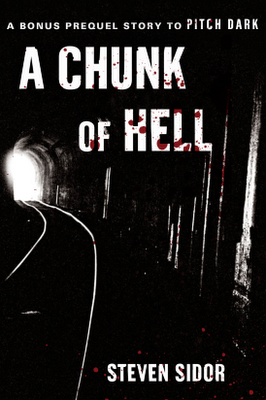 Here's the cover we're using for the bonus prequel to my upcoming novel, PITCH DARK. The story is a pulp weird tale written by one of the characters. It triggers all the events in the book. I had a great time writing it. Makes me wish I lived in the old Pulp Era. But, hey, maybe I'm living in the new one? Soon I'll have links where people can download "A Chunk of Hell" for free. Free! Free!
Here's the cover we're using for the bonus prequel to my upcoming novel, PITCH DARK. The story is a pulp weird tale written by one of the characters. It triggers all the events in the book. I had a great time writing it. Makes me wish I lived in the old Pulp Era. But, hey, maybe I'm living in the new one? Soon I'll have links where people can download "A Chunk of Hell" for free. Free! Free!
Published on March 22, 2011 08:26
March 21, 2011
Used & Abused: The Color Out of Time
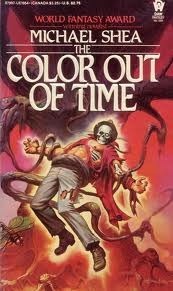 Michael Shea wrote one of my all-time favorite short stories, "The Autopsy." It's a smart, beautifully constructed, and frightening portrayal of alien invasion on an individual scale. He is also the author of perhaps my favorite Lovecraftian sequel, The Color Out of Time. This short novel, first published in 1984, is a continuation of Lovecraft's famous tale, "The Color Out of Space," which described the horrific effects of a meteor crash on a farm and the unleashing of a strange pervading alien intelligence. Shea's story brings the "creature down the well" into modern times. Set at a campground on the shores of a lake, above the flooded remains of the farm, the story's heroes are two retired professors and the artist sister of one of the camp's rangers. Shea brings the creeping terror with both hands. His prose is exquisite, conveying awestruck horror and gruesome violence equally well. I love this book and have reread it many times. I find an odd comfort in Lovecraft's universe of elder gods and mind-bending creatures from other dimensions. In many ways, Shea exceeds Lovecraft at his own game. Fans of horror/science fiction/fantasy will find plenty to enjoy here. "Vacationers in peril from monsters" is a horror genre cliche, but you've never read one like this. Pour yourself a whiskey, throw a log in the fireplace, and open this book. I highly recommend it.
Michael Shea wrote one of my all-time favorite short stories, "The Autopsy." It's a smart, beautifully constructed, and frightening portrayal of alien invasion on an individual scale. He is also the author of perhaps my favorite Lovecraftian sequel, The Color Out of Time. This short novel, first published in 1984, is a continuation of Lovecraft's famous tale, "The Color Out of Space," which described the horrific effects of a meteor crash on a farm and the unleashing of a strange pervading alien intelligence. Shea's story brings the "creature down the well" into modern times. Set at a campground on the shores of a lake, above the flooded remains of the farm, the story's heroes are two retired professors and the artist sister of one of the camp's rangers. Shea brings the creeping terror with both hands. His prose is exquisite, conveying awestruck horror and gruesome violence equally well. I love this book and have reread it many times. I find an odd comfort in Lovecraft's universe of elder gods and mind-bending creatures from other dimensions. In many ways, Shea exceeds Lovecraft at his own game. Fans of horror/science fiction/fantasy will find plenty to enjoy here. "Vacationers in peril from monsters" is a horror genre cliche, but you've never read one like this. Pour yourself a whiskey, throw a log in the fireplace, and open this book. I highly recommend it.
Published on March 21, 2011 06:27
March 10, 2011
Men's Adventure Novels: Edge #1, The Loner
 When I was a kid, my father knew a retired railroad detective who was dying slowly of cancer. This detective spent his time in his basement with a huge collection of guns and knives, some of which were highly illegal. He even had a grenade launcher. Well, Dad and I would occasionally visit to shoot the bull (I didn't really say anything, I just listened). And after each trip to the basement the detective would hand me a box of paperbacks. He spent a lot of the time he had left reading. And through him I discovered my first Lawrence Block, Ed McBain, and Charles Willeford novels. But early on the books of his I loved most were the Men's Adventure Novels. The Executioner, The Destroyer, and Max Allan Collins' Nolan series were favorites. I could read one or more in a day. I felt such excitement picking a new paperback out of the box. They were, in hindsight, totally inappropriate for a kid who just hit his teens. But in another way, the timing couldn't have been more perfect. My parents wouldn't let me see an "R" rated movie, but I could read anything I got my hands on. I read my first Westerns from those boxes. And none came badder than George G. Gilman's Edge series. They were spaghetti westerns in print form. Gilman was a pseudonym for Terry Harknett, one of the Piccadilly Cowboys (a group of UK pulp western writers). The Edge books were hyperviolent and hypersexual -- just what a hyper kid needed. What I remember most was Edge's complete outsider status. Book #1 was titled The Loner. Edge was an anti-hero, a half-breed sociopath, and an existentialist man apart. Like his cinematic counterparts, he stood the genre on its head and added a layer of grit, grease, and gore. I read dozens of books from each of those series, but every time I got a new box from the detective, I'd always dig for an Edge.
When I was a kid, my father knew a retired railroad detective who was dying slowly of cancer. This detective spent his time in his basement with a huge collection of guns and knives, some of which were highly illegal. He even had a grenade launcher. Well, Dad and I would occasionally visit to shoot the bull (I didn't really say anything, I just listened). And after each trip to the basement the detective would hand me a box of paperbacks. He spent a lot of the time he had left reading. And through him I discovered my first Lawrence Block, Ed McBain, and Charles Willeford novels. But early on the books of his I loved most were the Men's Adventure Novels. The Executioner, The Destroyer, and Max Allan Collins' Nolan series were favorites. I could read one or more in a day. I felt such excitement picking a new paperback out of the box. They were, in hindsight, totally inappropriate for a kid who just hit his teens. But in another way, the timing couldn't have been more perfect. My parents wouldn't let me see an "R" rated movie, but I could read anything I got my hands on. I read my first Westerns from those boxes. And none came badder than George G. Gilman's Edge series. They were spaghetti westerns in print form. Gilman was a pseudonym for Terry Harknett, one of the Piccadilly Cowboys (a group of UK pulp western writers). The Edge books were hyperviolent and hypersexual -- just what a hyper kid needed. What I remember most was Edge's complete outsider status. Book #1 was titled The Loner. Edge was an anti-hero, a half-breed sociopath, and an existentialist man apart. Like his cinematic counterparts, he stood the genre on its head and added a layer of grit, grease, and gore. I read dozens of books from each of those series, but every time I got a new box from the detective, I'd always dig for an Edge.
Published on March 10, 2011 19:01
March 3, 2011
Altered States
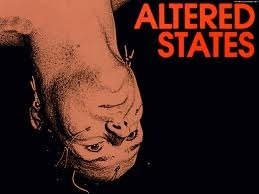 I'm a big fan of Body Horror. David Cronenberg is undoubtedly the king of the genre. He pretty much created it, and he certainly popularized it (Shivers, The Brood, Scanners, Videodrome, The Fly, eXistenZ, etc.). I love 'em all. But director Ken Russell did a fine job in 1980 with William Hurt's film debut, Altered States. Let's start with the opening shot of Hurt floating in a steampunk-ish tank, followed by the sliding title sequence. Really cool. But I'm a sucker for a good title sequence. The sound in this movie is excellent, and quality sound really does make a horror movie. Sound builds tension. Images release the tension. Another thing I like about this movie: it's a genre blender. It's science fiction. It's horror. But it's also a love story wrapped in an adventure story. Only the adventure is inward bound. Hurt plays a brilliant scientist who drinks a hallucinogenic mushroom soup down in Mexico and experiences a mind-altering trip back to the origins of human consciousness. Peachy keen! So he takes the soup back to his Harvard lab and experiments with it in his isolation tank. Every time I see this flick, I want one of those tanks. The score of this movie is creepy. And there's a great ensemble cast including Blair Brown, Bob Balaban, and Charles Haid. The film has a gritty realistic look, which always helps when you're going to introduce a lot of weirdness. That's exactly what Altered States does. Now the movie isn't perfect. The dialogue sounds pretentious -- but hey, they're Harvard professors! And the overly serious mumbo jumbo about finding the Truth comes across as silly. But there's a really infectious energy going on here, too. I want to be a part of this pseudo-scientific research project. Luckily, the movie doesn't spend too much time explaining the science part, because that's the weak link. The atmosphere and effects are genuinely frightening. Hurt's mad scientist, determined to explore humankind's ancestral self despite the risks to his transmogrifying body, provides the thrills. It's more intriguing than a bunch of high school hotties running from a madman with an ax (not that I'm knocking madmen with axes). Altered States overreaches, but it does so with gusto and visual zest. If psychedelic fringe science run amok is your thing, revisit this classic. Get naked and devolve!
I'm a big fan of Body Horror. David Cronenberg is undoubtedly the king of the genre. He pretty much created it, and he certainly popularized it (Shivers, The Brood, Scanners, Videodrome, The Fly, eXistenZ, etc.). I love 'em all. But director Ken Russell did a fine job in 1980 with William Hurt's film debut, Altered States. Let's start with the opening shot of Hurt floating in a steampunk-ish tank, followed by the sliding title sequence. Really cool. But I'm a sucker for a good title sequence. The sound in this movie is excellent, and quality sound really does make a horror movie. Sound builds tension. Images release the tension. Another thing I like about this movie: it's a genre blender. It's science fiction. It's horror. But it's also a love story wrapped in an adventure story. Only the adventure is inward bound. Hurt plays a brilliant scientist who drinks a hallucinogenic mushroom soup down in Mexico and experiences a mind-altering trip back to the origins of human consciousness. Peachy keen! So he takes the soup back to his Harvard lab and experiments with it in his isolation tank. Every time I see this flick, I want one of those tanks. The score of this movie is creepy. And there's a great ensemble cast including Blair Brown, Bob Balaban, and Charles Haid. The film has a gritty realistic look, which always helps when you're going to introduce a lot of weirdness. That's exactly what Altered States does. Now the movie isn't perfect. The dialogue sounds pretentious -- but hey, they're Harvard professors! And the overly serious mumbo jumbo about finding the Truth comes across as silly. But there's a really infectious energy going on here, too. I want to be a part of this pseudo-scientific research project. Luckily, the movie doesn't spend too much time explaining the science part, because that's the weak link. The atmosphere and effects are genuinely frightening. Hurt's mad scientist, determined to explore humankind's ancestral self despite the risks to his transmogrifying body, provides the thrills. It's more intriguing than a bunch of high school hotties running from a madman with an ax (not that I'm knocking madmen with axes). Altered States overreaches, but it does so with gusto and visual zest. If psychedelic fringe science run amok is your thing, revisit this classic. Get naked and devolve!
Published on March 03, 2011 13:36



